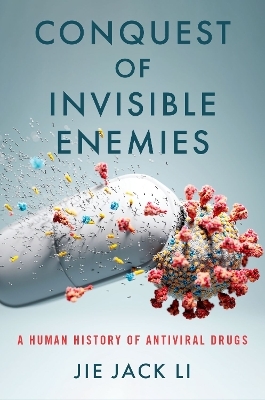
Conquest of Invisible Enemies
Oxford University Press Inc (Verlag)
978-0-19-760985-9 (ISBN)
It's time to examine the human history of viruses, vaccines, and antiviral drugs...
Public response to the COVID-19 pandemic has demonstrated that misinformation about viruses is widespread. Vaccine skepticism is rampant, and many people have been quick to accept bogus claims unsupported by science. In his latest book, Jie Jack Li sets the record straight by revealing the science and history behind antiviral drugs.
Conquest of Invisible Enemies: A Human History of Antiviral Drugs guides readers through the history of viruses, vaccinations, and treatments. Readers learn about the discovery of viruses and diseases, such as HIV/AIDS, hepatitis, influenza, and SARS-CoV-2 (COVID-19). The first chapter takes an expansive look at how viruses have shaped human history. Subsequent chapters narrow in on specific viruses, diseases, and drug treatments. For example, chapter four, on influenza, looks at the 1918 Spanish flu pandemic, the history of vaccination efforts, and influenza drugs and vaccines today. Chapter five, on coronaviruses, considers drug treatments for SARS, MERS, and SARS-CoV-2. It also discusses the development of COVID-19 vaccines and drugs.
Conquest of Invisible Enemies: A Human History of Antiviral Drugs focuses on the human drama behind drug discovery. Written in an engaging and accessible style, Li's timely book dispels common misconceptions about viruses and treatments and places the COVID-19 pandemic in historical context.
Jie Jack Li is the CSO of GenHouse Bio. Previously, he was VP of Discovery Chemistry at ChemPartner, an Associate Professor of Chemistry at the University of San Francisco, and a Medicinal Chemist at Pfizer and Bristol-Myers Squibb. He has authored or edited over 30 books, including Blockbuster Drugs (Oxford University Press, 2014), which won the 2015 Alpha Sigma Nu Science Book Award.
Preface
Chapter 1. Virus Shaping History and Discovery of Virus
1.1 Virus shaping history
1.1.1 Tulipomania: bubbles of bulbs
1.1.2 The fall of old Mexico and Peru
1.1.3 Succession of thrones
1.1.4 The Louisiana Purchase
1.2 Discovery of virus
1.2.1 The gem theory
1.2.2 Discovery of virus
1.2.3 Cancer-causing viruses
1.2.4 Discovery of retrovirus
Chapter 2. HIV/AIDS Drugs, Transforming a Death Sentence to a Chronic Disease
2.1 Discovery of the virus
2.1.1 A death sentence
2.1.2 Discovery of HIV and the great scientific controversy
2.1.3 The Nobel Prize
2.2 The first ray of hope
2.2.1 Nucleoside antiviral drugs
2.2.2 Non-nucleoside reverse transcriptase inhibitors
2.3 HIV protease inhibitors
2.3.1 HIV protease
2.3.2 First-generation HIV protease inhibitors
2.3.3 Second-generation HIV protease inhibitors
2.4 HIV integrase inhibitors
2.5 HIV Entry Inhibitors
2.5.1 HIV fusion inhibitors
2.5.2 CCR5 inhibitors
2.6 Triumph of modern medicine
Chapter 3. Hepatitis Drugs
3.1 Hepatitis A virus
3.1.1 Discovery of hepatitis A virus
3.1.2 Hepatitis A vaccines
3.2 Hepatitis B virus
3.2.1 Discovery of hepatitis B virus
3.2.2 Hepatitis B vaccines
3.2.3 Hepatitis B drugs
3.3 Hepatitis C virus
3.3.1 Discovery of Hepatitis C virus
3.3.2 Hepatitis C virus NS3/4A protease inhibitors
3.3.3 Hepatitis C virus NS5A replication complex inhibitors
3.3.4 Hepatitis C virus NS5B polymerase inhibitors
3.4 Triumph of modern medicines
Chapter 4. Influenza: A Perennial Killer
4.1 Influenza, a perennial killer
4.2 A virus that changed the world: the 1918 Spanish flu pandemic
4.3 Discovery of the influenza virus
4.4 Influenza vaccines
4.4.1 History of vaccination
4.4.2 History of influenza vaccines
4.4.3 Influenza vaccines today
4.5 Influenza drugs
4.5.1 M2 inhibitors
4.5.2 Influenza virus neuraminidase inhibitors
4.5.3 Cap-dependent endonuclease https://en.wikipedia.org/wiki/Ribonuclease inhibitor
Chapter 5. Coronaviruses
5.1 Coronavirus Drugs
5.1.1. SARS
5.1.2. MARS
5.1.3. SARS-CoV-2
5.2 COVID-19 Vaccines
5.2.1. Pfizer/Biotech's mRNA vaccine
5.2.2. Johnson & Johnson's viral vector vaccine
5.3 COVID-19 Drugs
5.3.1. Remdesivir (Veklury)
5.3.2. Dexamethasone
Chapter 6. Closing Remarks
Bibliography
Chemical Structures of Antiviral Drugs
| Erscheinungsdatum | 14.11.2022 |
|---|---|
| Zusatzinfo | 38 line drawings and 28 halftones |
| Verlagsort | New York |
| Sprache | englisch |
| Maße | 210 x 147 mm |
| Gewicht | 467 g |
| Themenwelt | Medizin / Pharmazie ► Medizinische Fachgebiete ► Psychiatrie / Psychotherapie |
| Studium ► Querschnittsbereiche ► Geschichte / Ethik der Medizin | |
| Naturwissenschaften ► Biologie ► Biochemie | |
| ISBN-10 | 0-19-760985-6 / 0197609856 |
| ISBN-13 | 978-0-19-760985-9 / 9780197609859 |
| Zustand | Neuware |
| Haben Sie eine Frage zum Produkt? |
aus dem Bereich


